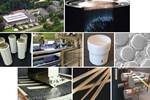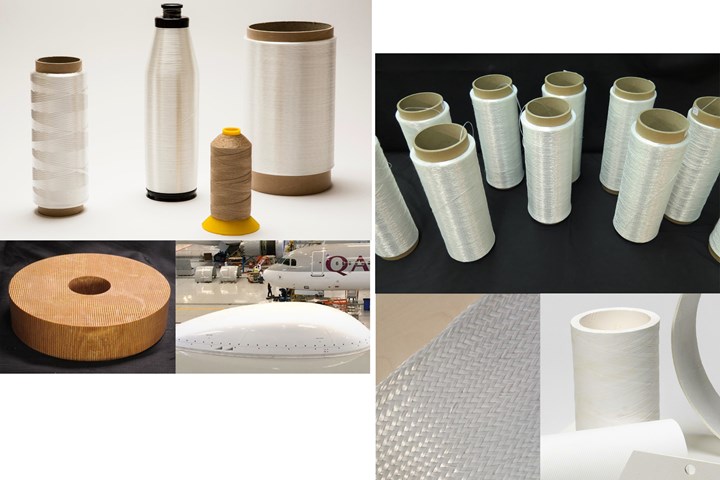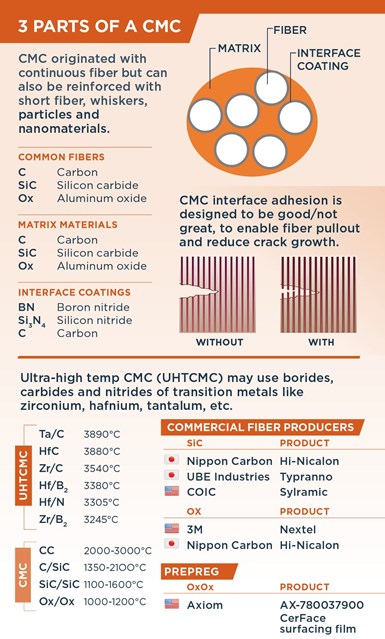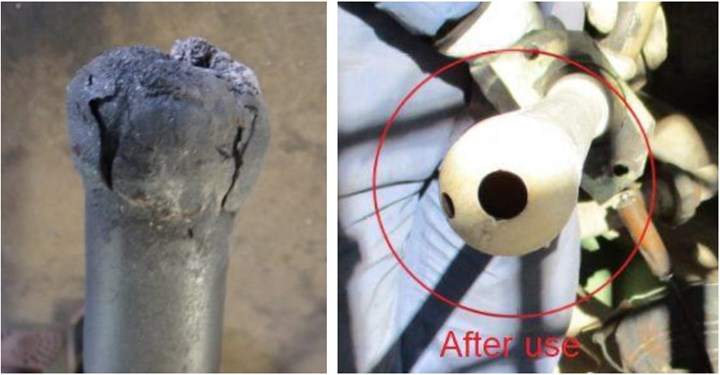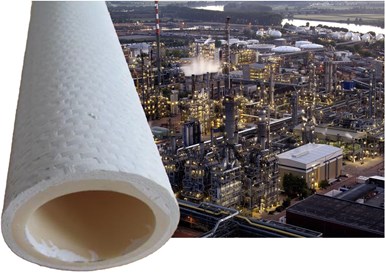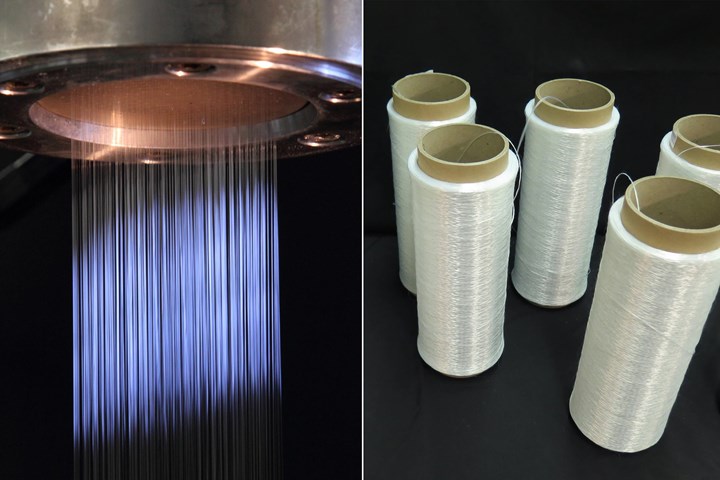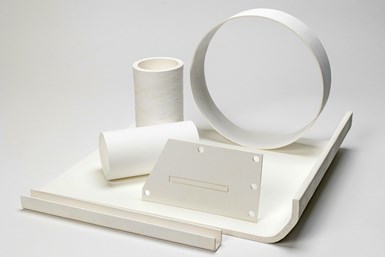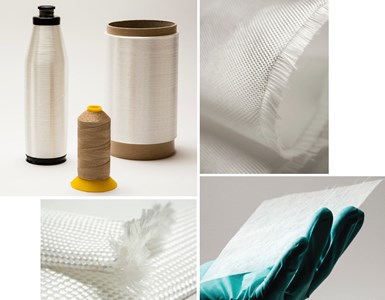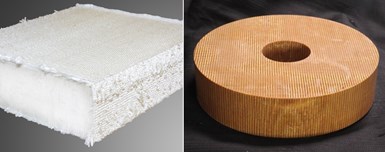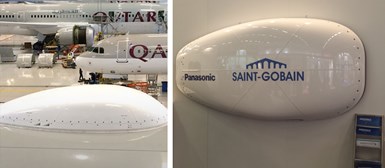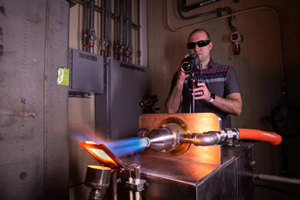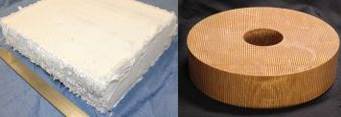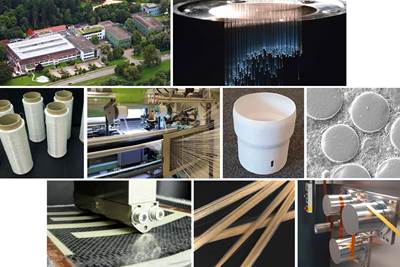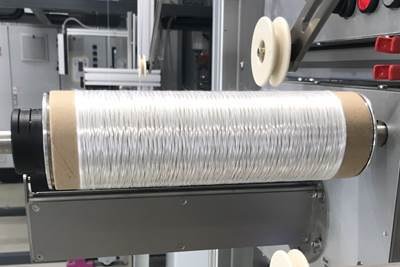The future of quartz and oxide fibers at Saint-Gobain Advanced Ceramic Composites
New business builds on 100-year legacy in quartz, prepares for growth, while starting production of oxide fibers to meet increased demand for CMC by aerospace and industrial sectors.
Saint-Gobain Advanced Ceramic Composites (ACC) produces quartz fibers and composites for thermal protection systems (TPC) and high-frequency radomes (left) as well as oxide ceramic fibers and ceramic matrix composites (CMC) that resist temperatures >1,100°C (right). Source | Saint-Gobain ACC, Bally Ribbon Mills
Saint-Gobain (La Défense, Paris, France) is a multinational brand well known in composites for its manufacture of glass fiber reinforcements through subsidiaries Vetrotex and Adfors. But its history, intriguingly, goes back to 1665, established to break the monopoly that Venice had in mirror manufacturing. From the subsequent development of the revolutionary table rolling process for glass in a small village in northern France, to the foundation of Quartz & Silice in 1922 by the engineer Henri George, to its introduction of F-Glas reinforcement fibers in 1930 in Germany — Saint-Gobain has been compelled by technological innovation.
Now, again, it seeks to break a monopoly, this time in the production of aluminum oxide (alumina) ceramic fibers used in ceramic matrix composites (CMC). But this is just one business within Saint-Gobain Advanced Ceramic Composites (ACC, Pierre-lès-Nemours, France). CW talks to Aymeric d'Ydewalle, appointed as general manager of ACC in 2022, to better understand the future for quartz and ceramic fiber composites.
Formation of Saint-Gobain ACC
Saint-Gobain Quartz (Saint-Pierre-lès-Nemours, France) has evolved into a new business: Saint-Gobain Advanced Ceramic Composites (ACC). Announced in April 2023, the name reflects the company’s focus on growth in high-potential markets, including:
- Quartzel quartz fiber which is high-purity >99.95% silica (SiO2) offering excellent dielectric properties and a unique combination of physical, mechanical and thermal properties not provided by other lower purity silica fibers like E-glass.
- Continuous alumina and mullite ceramic fibers with thermo-mechanical resistance and long-term stability up to 1,200°C.
- CMC made from oxide fibers in an oxide matrix, which can be formed into a wide array of shapes for parts offering durability at very high temperatures.
“Our business has a long history, celebrating its 100th anniversary in 2022,” says d’Ydewalle. “There has been a lot of innovation through the years, and quartz fibers remain the largest part of our business.” This history in quartz fiber is described below. But, as the company began to look at its next 100 years, its leaders began questioning how to expand and diversify its offerings. “We looked into possible adjacent products and technologies, which led us to considering oxide ceramic fibers,” he continues. “That led to concluding a deal almost 2 years ago with the DITF in Germany [Denkendorf], to acquire the technology they have developed in producing these fibers.”
“Our new name reflects our repositioning to encompass a range of high-performance fibers for composites,” says d’Ydewalle. “We have our legacy businesses in quartz with existing customers and business, but we are also bringing to market new technology in alumina fiber for CMC via the agreement with DITF. And we have decades of experience and knowledge that has been developed into Saint-Gobain global R&D centers, where we can help a broader set of customers infiltrate new applications across these materials. We believe CMC will emerge more and more in the next years and ACC will have an important part to play in that. Our intention is not only to become a global leader in such high-performance fibers, but we also want to accompany our customers into the adoption of CMC and other technologies in the future.”
New markets in CMC
Temperature range of SiC versus oxide CMC as well as existing fiber suppliers but note that only SiC fibers need to be coated. Oxide fibers achieve the necessary fiber/matrix interface without coating, which aids in their lower cost and less complexity. Source | CW
As explained in the 2023 article, “A new era for ceramic matrix composites,” although the CMC market really opened up with GE Aerospace’s use and production of silicon carbide (SiC/SiC) CMC for more efficient aeroengines, oxide fiber-reinforced oxide (Ox/Ox) CMC are also seeing increased demand.
In general, SiC/SiC is seen as a higher-temperature material (1,100-1,600°C) than Ox/Ox (1,100-1,200°C). However, as explained by Dr. Bernd Clauss, head of the DITF Competence Center High Performance Fibers, this capability depends on time and temperature (see CW’s blog on DITF). The lower figure for ox fiber aligns more with long durations, such as CMC turbine components that must survive 10,000 hours, he says, “but for applications … which survive for only 10 seconds, … oxide fiber can go to 1,500°C.” He adds that SiC/SiC composites are increasing in the hot section of aeroengines while Ox/Ox are used in adjacent lower temperature regions. However, oxide fibers don’t require coating like SiC fibers do and have a lower overall cost. “For oxide CMC, we put non-coated fibers in a matrix and get a porous matrix at the end, which gives a fiber-dominated behavior and the damage tolerance you need for CMC,” says Clauss.
OCMC burner lances used in steam crackers offer 10 times longer life than metal (top). OCMC are being used to increase efficiency in a variety of industrial processes. Source | Walter E. C. Pritzkow Spezialkeramik, BASF
So, there is a growing market for Ox/Ox CMC in aeroengines, but also in industrial applications. Again referring to CW’s 2023 article on CMC, these materials are increasingly being sought for use in thermal industrial processes, where higher temperatures increase efficiency. For example, prototype CMC reaction vessels have shown as much as 50-60% improvement in steam cracking of hydrocarbons. “We work mainly with industrial companies, but also with companies doing metal casting and heat treatment,” says Walter Pritzkow, who founded Walter E.C. Pritzkow Spezialkeramik near Stuttgart in 1994. The company’s award-winning Keramikblech Ox/Ox CMC (referred to as OCMC) uses fabrics made with 3M (Minneapolis, Minn., U.S.) Nextel 610 and 720 fibers and a hand layup process to create a wide array of parts. “We do small series of 10-100 parts but also larger production of parts like burner systems where we deliver 2,000 to 5,000 parts per year.”
Why not use SiC? “Because SiC/SiC and C/SiC are much more complex materials and require longer processing,” explains Pritzkow. He sees a large potential for OCMC parts in the future, with more applications being developed in recent years. “In the beginning, we worked with specialty companies and niche applications, but now large companies want to run thermal processes at higher temperatures. We have also worked with engine manufacturers.” He thinks this growth will be even faster if ox fiber costs come down. “We’ll get more opportunities to replace metal parts which are destroyed in weeks and months due to coking and corrosion,” he explains. “OCMC parts provide a much higher lifetime — for example, our flame tubes last up to 4 years.” His industrial customers have found these parts provide a significant reduction in maintenance, shutdown and part replacement costs.
Offering a new supply of oxide fiber
The oxide fibers that Saint-Gobain ACC is commercializing at its French facility have been validated in a pilot line at DITF since 2018, woven into fabrics as well as small- and large-scale braided textiles, and successfully converted into OCMC parts. Source | DITF, Saint-Gobain Advanced Ceramic Composites
One obstacle for OCMC growth has been a limited supply of fiber. To date, almost all OCMC use Nextel 610 and 720 fibers from 3M. Other suppliers have left the market, and Nitivy [Tokyo, Japan] fibers with 85%+ oxide content are reportedly still in development. “Nextel fabric is the most expensive part of our products,” notes Pritzkow, “and delivery is a problem, often with delays of 3-6 months.”
This will change in 2025, when ACC will make its continuous oxide fibers commercially available from its French production site. “Our first target is 4-5 tons/year,” says d’Ydewalle. This will be expanded quickly to 10+ tons/year.
Saint-Gobain will commercialize OxCeFi A99 and OxCeFi M75 fibers, which were developed by DITF over decades, with production validated in a pilot line since 2018. According to DITF, OxCeFi A99 fiber is similar to Nextel 610, being 99% corundum (α-alumina), without using iron oxide for controlled structure formation. However, DITF claims there is no counterpart to OxCeFi M75 fiber which is 96% mullite, because Nextel 720 is typically a mixture of corundum and mullite. OxCeFi M75 reportedly offers similar creep resistance but optimized high-temperature stability. Pritzkow has tested these oxide fibers in unidirectional and woven fabrics and confirms they are at the same level as Nextel fibers. He has also assisted in validating the fiber’s performance in OCMC parts.
Saint-Gobain ACC enabling OCMC growth
“Saint-Gobain has been working toward ox-ox CMC for many years,” says d’Ydewalle, “in collaboration with a broad set of customers, especially in Europe, and also jointly with a number of sister businesses within Saint-Gobain that see potential in CMC.” For example, Saint-Gobain has a lot of experience serving the market with monolithic ceramics in a wide set of applications, and sometimes there are constraints in terms of stress and temperature that demand more advanced products, like CMC.”
Saint-Gobain ACC produce a wide range of high-performance ceramic fiber-reinforced composites. Source | Saint-Gobain Advanced Ceramic Composites
“We have taken ownership of this long-term R&D work and will continue that with a variety of partners,” says d’Ydewalle. For example, Saint-Gobain ACC is included in a multi-year program funded by France and the European Union (“France 2030” & “Next-Generation EU supporting Relaunch France”) with a leading French aerospace company, announced in 2023. “Today, we have the capability to make small- and medium-scale samplings of oxide fibers in France, and we are developing our CMC capability. Our initial focus is on OCMC, for which we are leveraging a variety of materials including alumina, silica and quartz — so that we can cover quite a wide range of applications and performance.”
In addition to aeroengines, d’Ydewalle says other key markets are space and non-civilian applications. “Such key technologies have become a matter of sovereignty,” he explains. “We see that France and Europe do not want to have such a critical dependency on the U.S. even though it’s a strong ally. They prefer to have their own supply chains.”
Outside of aeroengines, space and non-civilian markets, d’Ydewalle sees an even wider set of opportunities than just the refractory and chemical industries. “We also see possible applications in hydrogen systems and batteries for automotive and eVTOL aircraft — all kinds of applications that need improved materials to resist high temperatures. This is where having our vertical integration and being able to propose novel solutions to our customers is important. It’s not like in aerospace where there is a big competency in CMC that has been developed at all the main aerospace jet engine players. In these other segments, CMC is still new. So, we need to work with customers here to help develop and validate parts in these applications to demonstrate that the technology makes sense. Also, it’s a way to differentiate ourselves versus the big players out there. We have no interest in being just another supplier, we want to work with and enable our customers.”
History in quartz fiber
Quartzel fiber can be processed into woven textiles, braids and nonwoven veils. Source | Saint-Gobain ACC
The first fused quartz filaments were produced by Saint-Gobain Quartz in 1960 in Nemours, France. Developed for space and non-civilian programs, applications quickly expanded beyond France. “In 1974, we worked with Lockheed Martin to make parts for the U.S. Space Shuttle,” says d’Ydewalle. “And in the years after, decided to support the U.S. demand by having operations there. So, we established our plant in Louisville, Kentucky in 1988.”
He notes that quartz is a unique product with a special balance of properties that result from its high-purity silica composition and its form as a fine filament that is high strength and thermally resistant, with high electromagnetic transparency while being flexible enough for efficient processing through many value add steps in the supply chain to create complex and tailored advanced composite parts.
The market for quartz composites continued to grow, explains Eric J. Smith, sales and marketing manager for Saint-Gobain ACC in an article published in the May/June 2023 issue of the SAMPE Journal. This was driven primarily by demand for electromagnetic transparent composite radomes as early as the 1970s in non-civilian aircraft programs. From these early successes, the use of quartz fiber composites in radomes grew to other aircraft, as well as naval programs, both in the U.S. and Europe. Quartz fiber was also used in other critical aviation parts including leading edge stealth structures, thermal dissipation skins and ablative surfaces for spacecraft thermal protection systems (TPS) necessary during atmospheric reentry.
3D woven preforms using Quartzel fiber help boost performance in compression pads, part of the TPS for the Orion spacecraft. Source | Saint-Gobain ACC “Heat shielding for spacecraft” and Bally Ribbon Mills
An important example is the compression pads which form part of the TPS for NASA’s Orion spacecraft (NASA worked with 3D weaver Bally Ribbon Mills (BRM, Bally, Penn., U.S.) in the project “3D Multifunctional Ablative TPS (3D-MAT) for Orion Compression Pad” which began in 2012). “We chose quartz fiber because it has low thermal conductivity and is a resilient fiber, not as brittle as carbon [fiber],” explains Ethiraj Venkatapathy, NASA Ames’ principal technologist for Entry Systems and team leader for Advanced TPS development. NASA and BRM worked to produce a 3D woven fabric that was infused with resin to form the compression pads now flying on the Orion spacecraft, which will carry crew into space on NASA’s Artemis missions. (see first section of CW’s 2018 article on the HEEET program and “First 3D woven composite for NASA TPS”).
Quartz is used to make Ku band Radomes which enable wifi on commercial aircraft. Source | Saint-Gobain Twitter post and “Keen on connectivity?” by RunwayGirlNetwork.com
By 2000, quartz composite radomes were being used by commercial aircraft to enable SATCOM wifi connectivity. The Boeing 787 Dreamliner was Boeing’s first commercial program to use a composite radome reinforced with woven quartz fabric prepreg. As weather antennas and avionics have advanced, the speed and amount of critical data has increased, which is now driving demand for quartz composites. “We see a growing need for quartz for wifi and nose radomes in both civilian and non-civilian aerospace applications,” says d’Ydewalle.
Digitization driving growth, future products
“More data and connectivity mean higher frequencies are used,” he explains. “We've invested in R&D for circuit boards in electronics and can see that in the years to come — boosted especially by the emergence of AI — there’s going to be a need for copper clad laminates [CCL] used for printed circuit boards [PCB] that can support very high frequency signals.” He notes that above 30 gigahertz, the dielectric properties of typical reinforcements like glass fiber would damage the integrity of the signal, which can cause the PCBs to become slow or unreliable and ultimately degrade the electronics.
“We are preparing for this future where certain CCLs will need to use quartz to maintain signal integrity at extremely high frequencies,” says d’Ydewalle, noting these applications spread widely beyond aerospace. “There are data center switches that route the data in all kinds of systems. And with AI, there is a tremendous increase in the amount of data that needs to be processed, which demands extremely high frequencies. These applications thus demand better hardware. Basically, you would have less processability and less capability to process the data if you used glass fiber PCBs.”
As part of meeting this market demand, Saint-Gobain ACC is developing new quartz fiber products. “Typically, the aerospace market requires yarns that are 9 and 14 microns in diameter,” says d’Ydewalle. “But to meet the standard product sizes established in the electronics market, there is a need to provide diameters of 7 microns or even below. And this is challenging because the thinner the quartz fiber is, the more fragile it is. Thus, it also drives new thresholds in process control, but we are meeting these challenges and preparing for this growth.”
Related Content
A new era for ceramic matrix composites
CMC is expanding, with new fiber production in Europe, faster processes and higher temperature materials enabling applications for industry, hypersonics and New Space.
Read MoreGeneral Atomics wins DOE contract to develop silicon carbide CMC for fusion power plants
GA-EMS will leverage experience with SiGA SiC/SiC cladding for nuclear fuel rods to develop new SiC composite foam and other materials for fission and magnetic fusion programs.
Read MoreORNL, Sierra Space create novel C/SiC TPS for reusable space vehicles
CMC tiles will be used on the Sierra Space DC100 Dream Chaser spaceplane carrying critical supplies and science experiments to and from NASA’s ISS.
Read MoreGE Aerospace awarded demonstration contract for NASA HyTEC project
Turbofan engine small core technology development with CMC-coated components targets enhanced fuel efficiency in single-aisle aircraft by mid-2030s.
Read MoreRead Next
First 3D woven composite for NASA thermal protection systems
A NASA-led team develops 3D woven quartz preform, hybrid process to infuse it with cyanate ester resin (0.5% voids) and achieves TRL5 in three years to replace CF/phenolic in the Orion spacecraft’s compression pads.
Read MoreDITF Denkendorf advances sustainable carbon fibers, oxide fibers for CMC and more
The German Institutes of Textile and Fiber Research are targeting more sustainable carbon fiber via low-pressure stabilization and bio-based precursors, and working with Saint-Gobain to commercialize oxide ceramic fibers for CMC.
Read MoreRATH works with InVECOF project to mature oxide fiber production in Europe for CMC
Producer of Altra ceramic staple fibers aims to scale up continuous Ox fibers to compete with Nextel 610 and 720, and with its partners, offer improved fibers with creep resistance for higher temperature CMC applications.
Read More


